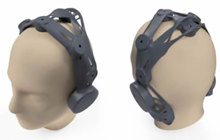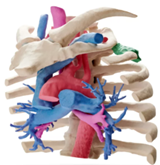3D printing in medical rehabilitation
Normally, the recovery of spinal cord injury patients takes place in hospitals, due to the complexity of the rehabilitation process and specific infrastructure requirements. In order to relieve the burden on rehabilitation wards and enable recovery at home, the University of Glasgow’s Department of Biomedical Engineering designed and manufactured an electroencephalography (EEG) headset to help restore hand function. The PhD student behind the project, Nina Petric-Gray, using a gaming headset as inspiration, made a 3D model of the headset on which electrodes were placed to record the patient’s brain activity. Functional electrical stimulation (FES), or low-energy pulses used to artificially generate body movements, is used for the rehabilitation process. The use of HP MJF 3D technology in this project proved to be the best option due to the lack of additional post-production processes and the high quality of the resulting prints in a short time. PA12 polyamide was used to ensure high print detail, resistance to the stresses created by daily use and biocompatibility.

Figure 1: Portable headset for spinal cord injury rehabilitation
HP MJF 3D in diagnostics and medical education
Modern medicine is moving towards a more personalised representation of the part of the body being examined or treated spatially, in order to provide medical staff with a more accurate knowledge of a specific disease case. Using a 3D model, doctors can correctly determine the size and location of lesions, resulting in increased safety of the procedure for the patient. The mapping of veins, arteries and other internal structures allows the development of a treatment strategy, minimising the possibility of complications. Additionally, printed anatomical models of organs are invaluable in educating both doctors and patients prior to surgery. The use of HP MJF 3D technology ensures the best strength and dimensional accuracy of the prints, additionally they are produced in full colour palette. The technology, based on PA11 and PA12 polyamides, allows for the production of elements with the most homogeneous properties; additionally, a great advantage of this method is the high speed of model printing.

Figure 2: Anatomical model printed using HP MJF 3D technology, PA11 and PA 12 material
HP MJF 3D revolutionises medical device manufacturing
The development of additive technologies is increasing the use of 3D printing for making prototypes or short runs of products such as forceps, medical clamps or scalpel handles. Such components do not directly interfere with living tissue, so they are subject to fewer regulations and barriers in the manufacturing process. Products made using 3D printing technology are significantly cheaper than standard instrumentation, plus modifications suggested by surgeons, for example, can be made to the tools. HP MJF 3D technology can be used to make both tools and components for laboratory machinery. Everex is using HP MJF 3D technology to create components for its Hemo One device for analysing blood samples. Currently, its four components are made additively: a sampler arm, two sample reagent plates and an electronic auxiliary device. Such components are created faster and at a lower cost, making the company more competitive in the market.

Figure 3. Hemo One sampler arm printed with HP JF 4200 3D using PA 12 material
Małgorzata Kubiś


